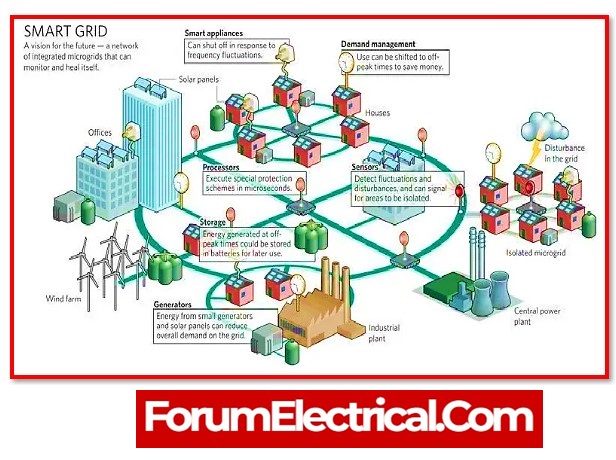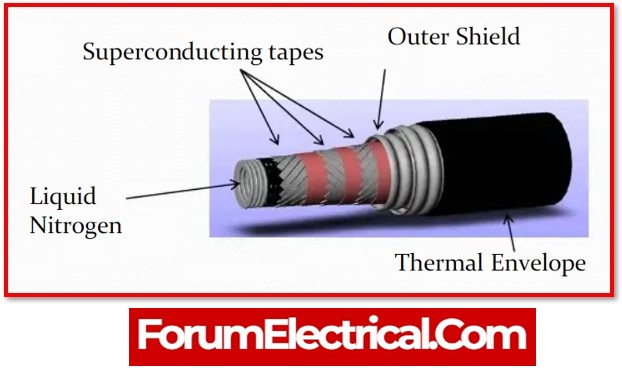- What is a Grid?
- What is a Smart Grid?
- What parameters determine a Smart Grid?
- Smart Grid Components
- Cables (High Temperature Wire) for Smart Grid
- Smart Meters for Net Metering
- What is the Operation of a Smart Grid?
- Features of Smart Grid
- Advantages of Smart Grid
- Disadvantages of Smart Grid
- Application of Smart Grid
- Difference between Electricity Grid and Smart Grid
- Electricity Grid vs Smart Grid
What is a Grid?
The term “Grid” refers to a “Electric Grid,” which is essentially a complete network consisting of
- Transmission lines,
- Transformers,
- Distribution substations, and any other accessories
that are used for the transmission and distribution of electricity from generation plants to residential and commercial scales. The term “Grid” is also called as “Electric Grid.”

As the process of development, the implementation of digital technology inside the grid system was necessary in order to ensure that it functions well.
This new digital technology permits two-way communications, which ensures a direct contact between utilities and all users.
What is a Smart Grid?
A smart grid is a network for the distribution of energy that is built on digital technology and is used to distribute power to customers via the use of digital communication that may go in both directions.
This system enables monitoring, analysis, control, and communication throughout the supply chain, which may assist enhance efficiency, lower energy consumption and costs, and optimise the supply chain’s transparency and dependability.
By incorporating smart net meters into the system, the “smart grid” was developed with the intention of improving upon the shortcomings of standard electricity networks.
Numerous government organisations all over the globe have been actively promoting the adoption of smart grids due to the potential of these grids to regulate and address issues relating to
- Global warming,
- Emergency resilience, and
- Energy independence.
What parameters determine a Smart Grid?
The following is a list of the four types of advanced technologies that will be required to convert a conventional electrical grid into a smart grid:
- Completely automated and integrated communication in both directions between all of the many components that comprises an electric grid.
- Controlling automatically the distribution of electricity, along with any defects or repairs.
- A superior advanced management panel, decision-making software, and process are being developed.
- Technology for accurate sensing and measuring applications.

The performance of the upgraded technology of
- Smart grids automation equipment &
- Control system
is accurate to meet the fast expanding demand for power, and this need is being met by the smart grid’s ability to fulfil it.
During a time, when these smart grids were not being deployed, all utility companies were required to send their respective professionals to obtain data connected to consumers and to take meter readings.
Smart Grid Components
A smart grid may link millions of transmission lines to power an entire nation. Various components of the smart grid design work together to improve grid efficiency, dependability, resilience, and stability. Additionally, via integrated grid management, the updated smart grid encourages customer control and cost savings.
A wide range of applications are able to process information and communicate with one another owing to the use of embedded systems in a smart grid.
The following are the major components of a smart grid:
- Electric power generators
- Electric power substations
- Cables
- Circuit breakers
- Collector nodes
- Controllers
- Distribution and transmission lines and control centers
- Smart meters (SMs)
Cables (High Temperature Wire) for Smart Grid
- HTS wires are high temperature superconducting wires.
- Can transport 3-5 times the electricity.
- Liquid Nitrogen is used to maintain the temperature at -200oC.
- Transmission losses shall be reduced as much as possible.
Smart Meters for Net Metering
- Communication in both directions.
- Computerization to replace the functions of the current method.
- Includes a CPU, non-volatile storage &communication facilities.
- By utilising a smart meter, users may reduce their energy use by 10%.
What is the Operation of a Smart Grid?
A system that is both environmentally friendly and energy efficient, such as a smart grid, makes it much simpler to make the shift to a low-carbon economy.
A smart grid is one that links every component of the energy system throughout all of its phases, including power production, transmission, storage, and distribution, where electricity is consumed.
Creating an integrated data and energy grid requires each device to be integrated using a plug-and-play methodology.
Because of its two-way interactivity, a smart grid is able to immediately redirect energy in the event that there is a power outage or a malfunction in any of the equipment.
Ex: A large-scale and extended power outage may be avoided by locating and isolating the source of the problem.
Users are able to engage on a deeper level and more quickly in demand response (DR) with a smart grid, as opposed to a standard grid, which only allows for significant input .
Features of Smart Grid
1). Load Handling
The demand on the electricity grid as a whole is not steady; rather, it fluctuates over the period of time. In that condition there is a significant load on the grid, a smart grid system may advise users to temporarily reduce their energy usage.
2). Demand Response Support (Customer Demand)
Users are provided with an automatic method to cut their monthly power costs. This method instructs customers to use electronic devices with lesser priorities during times of the day when the rates are lower.
3). De-centralization of Power Generation (Renewable)
A distributed or decentralised grid system gives each user the ability to produce electricity locally at their location using any method (ex: solar, wind) that is suitable, at the user’s option.
Advantages of Smart Grid
- Transmission & distribution of electric power that is both effective and efficient.
- After a power outage caused by defects, the electric power has to be quickly restored.
- Reduced expenses for utilities and their customers in the areas of operation, maintenance, and administration, as well as power.
- Because of the lower peak demand, electric power tariffs and prices have decreased.
- It would be helpful if there were more alternatives for integrating renewable energy into systems that generate their own electricity.
- Enhance both the protection and the security.
- It has the ability to fix itself.
- It encourages the engagement of consumers in the operations of the grid.
- It prevents power loss while supplying electricity that is of the highest possible standard and reliability.
- It paves the way for the expansion and profitability of the power sector.
Disadvantages of Smart Grid
- The most critical concerns are confidentiality and safety.
- A smart grid incorporates automated meter, advanced sensors, and two-way communications between consumers and providers of electrical power. Some types of meters are subject to being hacked.
- If a hacker were to acquire control of thousands or even millions of meters, the demand for electricity might either increase or decrease.
Application of Smart Grid
- The effectiveness of transmission lines is enhanced by the Smart Grid.
- Rapid restoration of service after any unexpected disruption to the lines and feeders.
- The reduction of costs.
- a decrease in the demand at its maximum peak demand.
- They have the capability of being integrated with renewable energy sources on a big scale, which may result in the sharing of load as well as the decrease of demand on a large scale.

Difference between Electricity Grid and Smart Grid
Electricity Grid vs Smart Grid
| Serial No | Electricity Grid | Smart Grid |
| 1 | The system is Electro-mechanical system | The system is completely digital smart-grid system |
| 2 | Flow of electricity and communication in only one direction (one-way communication) | Flow of power and information in both directions (two-way communication) |
| 3 | Generation of electricity that is centralised | Generation of electricity that is distributed |
| 4 | Radial grid topology architecture | Grid topology for the network |
| 5 | Manual surveillance (no real-time monitoring) | Complete realtime monitoring |
| 6 | Manual repair while restoring service | Self-reconfiguration during the recovery from an outage |
| 7 | Totally controlled by a utility corporation | The involvement of the customer is both improved and increased |
| 8 | Failures and blackouts are more probable. | Reduced potential for power outages brought on by the adaptive and islanding features of the system. |
| 9 | There is no energy storage. | Strong potential for energy storage |
| 10 | Delay of response time | Fast response time |
| 11 | Minimal sensor deployment | High density of deployed sensors (complete grid sensor layout) |
| 12 | Inadequate energy efficiency | Very efficient use of energy |
| 13 | Minimal integration of RER (renewable energy resources) | Large-scale RER integration |
| 14 | Less environmental protections | To be friendlier to the environment |
| 15 | Limited user choices | More choices for end users |




